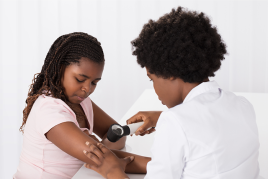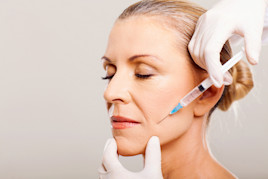November is National Healthy Skin Month®
What is National Healthy Skin Month?
The American Academy of Dermatology (AAD) designates each November as National Healthy Skin Month
It’s a time to pay attention to your skin, learn about skin care, and adopt habits that can lead to a lifetime of healthier skin, hair, and nails.

The AAD launched the first National Healthy Skin Month in November 1997. Since then, it’s become an annual event in which the AAD and dermatologists:
Emphasize the importance of good skin care.
Share tips that can lead to healthier skin, hair, and nails.
Ask Americans to take time to pay attention to their skin and adopt healthy habits to care for their skin, hair, and nails.
Who can participate in National Healthy Skin Month?
Everybody needs good skin care — from newborns to people more than 100 years old. That’s why National Healthy Skin Month is everyone’s awareness month.
To help you keep your skin looking its best, this November, the AAD is spotlighting unsafe skin care trends.
5 unsafe skin care trends to avoid
Board-certified dermatologists are seeing these unsafe trends on social media and elsewhere. Here are five that dermatologists say you should avoid:
Performing cosmetic treatments at home. Dermatologists agree. This skin care trend is one of the most worrisome. People are microneedling their own skin, injecting themselves with fillers, and using lasers to remove their own unwanted hair.
“This is something I find really concerning,” says board-certified dermatologist Sara Moghaddam, MD, FAAD. “For example, at-home microneedling, also known as dermarolling, is dangerous due to risk of infections and improper techniques,” she added.
Board-certified dermatologist Oyetewa Oyerinde, MD, FAAD says, “[My] patients will see people who document their entire [experience performing a cosmetic procedure] on TikTok or on Instagram. I tell patients, even if their immediate effect looks good to you — and they may be using filters and other things to make it look good — you have no idea if they ended up in the emergency room afterward because of a bad reaction.”
Bottomline: So many complications can occur when you perform a cosmetic procedure, like injecting fillers or removing unwanted hair with a laser, at home. Board-certified dermatologists have the expertise and training needed to safely perform cosmetic procedures. They can also tell you whether a procedure is right for you. No procedure is right for everyone.Trying nasal tanning spray. If you want to look tan, self-tanner that you apply to your skin is a safe way to get that look. Nasal tanning spray is not. For nasal tanning spray to work, you need to first inhale the spray and then spend time in the sun without protecting your skin from the sun.
The sun exposure increases your risk of developing skin cancer and signs of premature skin aging like wrinkles and age spots.
None of the active ingredients in nasal tanning spray are approved or regulated by the U.S. Food and Drug Administration (FDA) for this purpose. Melanotan is one such active ingredient. Board-certified dermatologist Lindsey Zubritsky, MD, FAAD, says, “Melanotan isn’t approved or regulated by the FDA, and it’s illegal to sell it in many countries, including the United States."
Possible side effects of using nasal tanning spray include suddenly developing a number of new moles and freckles. This product can also cause your moles to change color or darken.
Bottomline: If you want to look tan, use a self-tanner that you apply to your skin. Nasal tanning spray is unregulated, which makes it risky. Using this spray also requires you to spend time in the sun without sun protection, which increases your risk of developing skin cancer.Using hot peppers to make lips fuller. Dr. Oyerinde says, “Hot peppers have also made the rounds on social media as a pantry-ready way to achieve a fuller lip look. I’ve seen people use peppers, like Scotch bonnet or habañero, to get their lips to look bigger temporarily.”
“That is potentially very dangerous, because it can cause allergic contact dermatitis, or other rashes that can leave dark spots around the mouth or on the lips that are hard to get rid of,” says Dr. Oyerinde.
Bottomline: If you want fuller lips, see a doctor who has experience and training in adding volume to the lips, like a board-certified dermatologist. Your dermatologist knows how to inject FDA-approved dermal fillers safely. When injected by a doctor who has the necessary experience and training, a lip filler has a low risk of causing complications and can give you natural-looking results.Taking supplements randomly. “The practice of taking supplements for anything and everything is another trend that I think may be doing more harm than good,” says board-certified dermatologist Angelo Landriscina, MD, FAAD. Dr. Landriscina warns, “People are taking them on a whim after seeing social media content, and they start and stop taking them without consulting a physician.”
Bottomline: If you think that a supplement could treat a skin, hair, or nail concern, see a board-certified dermatologist. “Ingredients in supplements advertised for skin, hair, and nails have been linked to birth defects, an increase in cancer risk, and even side effects such as acne and hair loss,” says board-certified dermatologist Rajani Katta, MD, FAAD.Skipping the sunscreen. To use or not to use sunscreen is another topic that’s been trending on social media.
Dr. Zubritsky says, “I’ve seen a huge rise in anti-sunscreen sentiment on social media, which is quite concerning. A significant number of people are posting about the harmful effects of sunscreen and claiming that most sunscreens lead to cancer or contain cancer-causing ingredients.”
These claims aren’t backed by science. The FDA, which regulates sunscreen, says, “Given the recognized public health benefits of sunscreen use, Americans should continue to use sunscreen with other sun protective measures.” This FDA recommendation is based on current scientific evidence, and the science doesn't show that any sunscreen ingredients currently available in the United States are harmful to human health. That’s why the AAD recommends that people protect their skin while outdoors by:- Seeking shade.
- Wearing protective clothing — including a long-sleeved shirt, pants, a wide-brimmed hat, and sunglasses with UV protection.
- Applying a broad-spectrum, water-resistant sunscreen with an SPF of 30 or higher to all skin not covered by clothing.
Your dermatologist knows skin care
Harmful skin care can take a toll on your skin and sometimes your self-esteem. A good way to tell if the advice is trustworthy is to look at who’s giving it. If the advice comes from a board-certified dermatologist, you know it comes from the skin, hair, and nails expert.
You’ll find trustworthy skin care advice from board-certified dermatologists on this website. For daily tips from board-certified dermatologists, follow the AAD on social media, using the links at the bottom of this page.
Image
Getty Images
References
American Academy of Dermatology, “American Academy of Dermatology’s statement on the National Academies of Sciences, Engineering, and Medicine’s report on environmental impact of currently marketed sunscreens and potential human impacts of changes in sunscreen usage.” News release issued 8/9/2022. Last accessed 10/6/2023.
Margosian E. “From slugging to snail mucin: Dermatologists discuss popular social media trends impacting the skin.” Dermatol World. 2023;33(10):24-30.
Splete H. “Are nutritional supplements aimed at skin care helpful, harmful, or simply a placebo for patients?” Dermatol World. 2023;33(7):18-24.
Written by:
Emily Margosian
Paula Ludmann, MS
Reviewed by:
Brendan Camp, MD, FAAD
Amanda Friedrichs, MD, FAAD
Sanna Ronkainen, MD, FAAD
Last updated: 1/24/24
 Molluscum contagiosum: How to safely treat it
Molluscum contagiosum: How to safely treat it
 Biosimilars: 14 FAQs
Biosimilars: 14 FAQs
 Practice Safe Sun
Practice Safe Sun
 Relieve uncontrollably itchy skin
Relieve uncontrollably itchy skin
 Fade dark spots
Fade dark spots
 Untreatable razor bumps or acne?
Untreatable razor bumps or acne?
 Laser hair removal
Laser hair removal
 Scar treatment
Scar treatment
 Botox
Botox
 Free materials to help raise skin cancer awareness
Free materials to help raise skin cancer awareness
 Dermatologist-approved lesson plans, activities you can use
Dermatologist-approved lesson plans, activities you can use
 Find a Dermatologist
Find a Dermatologist
 What is a dermatologist?
What is a dermatologist?